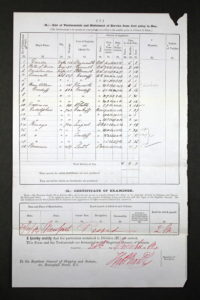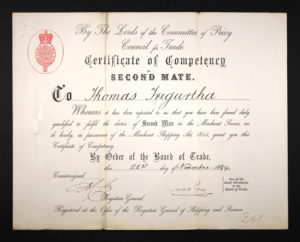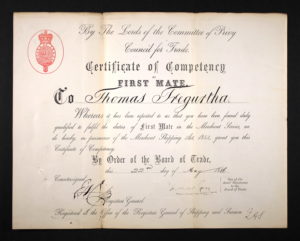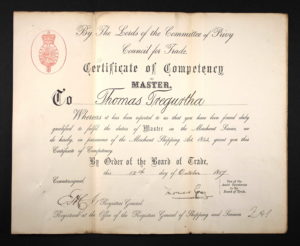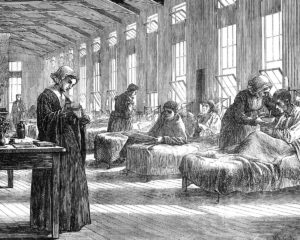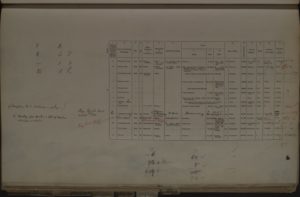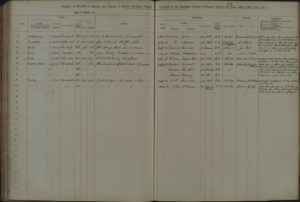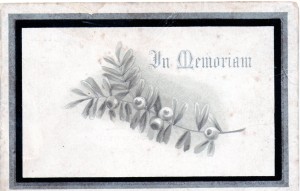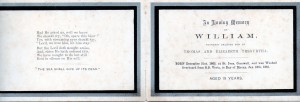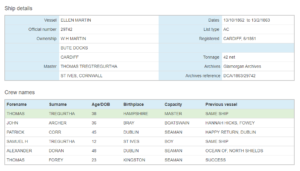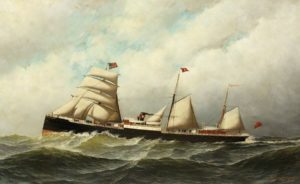William Tregurtha and older brother Thomas (jnr) were were seafarers at heart, fulfilling a role that was vital to the growth and sustainability of the British Empire. Having roots in the seaside town of St Ives, in the English county of Cornwall, the brothers lived and breathed the nautical life. Their father Thomas snr was a mariner, and their grandfather John Tregurtha was in the merchant navy as a young lad, then worked for the Coast Guard in St Ives.
William (b.1865) and Thomas jnr (b.1861) grew up together around the dockyards of St Ives in the 1860’s, and probably tugged at their father’s coat with the hope of following him on one of his many oceanic endeavours. They watched as countless ships sailed into port daily, watched as the cargo was loaded and unloaded, and eventually grew accustomed to hearing the mariner’s unique language, known colloquially as “jackspeak”. In fact, being young boys, we can almost be certain that William and Thomas annoyed their mother and siblings with the mimicking of different terms and phrases from that old naval slang.
The Merchant Navy, as it is known today, came into being during the 17th century, when the government made an attempt to register all seafarers, in order to call them up for duty in the Royal Navy during times of conflict. The government’s attempts were unsuccessful. Merchant seamen were not happy with having to register and became suspicious of any agenda that might lead to service under duress in a royal ship, where the pay was both inferior and often delayed. Not to mention the living conditions aboard Navy vessels, which tended to be more cramped than those in merchant vessels which had smaller crews.
Many years later, in 1835, the Merchant Shipping Act was passed. This required all men serving in the Merchant Nay to register formally, and if called, to serve in the Royal Navy. It was now compulsory for mariners on merchant vessels to give their personal details, including place of birth, age, and often the date of their attestation or apprenticeship. These records are invaluable for tracing an ancestor who served in the merchant service. However, the system unfortunately became unmanageable and was abandoned in 1857. Therefore, there is only a twenty-year window of records which provide detailed information about an ancestor who was in the Merchant Navy. Fortunately there is a database titled Mates & Masters Certificates, issued by the British Board of Trade between 1850-1927. This can provide a wealth of information about an individual, including years of service and names of vessels upon which he served.
THOMAS Jnr
Thomas began his career in the merchant navy at the age of 14, in 1875, embarking on the brig Guide, registered in the port of Weymouth, Dorset. By the time of Thomas’ 20th birthday in 1881 he had made ten voyages at sea, in seven different vessels, sailing in and out of the major ports of Weymouth, Plymouth, Falmouth, Cardiff, and Whitby. One of the ships he sailed on was the S.S. Cornwall pictured above. Others include the S.S. Henry Allan, the S.S. Cardiff, and the S.S. Godolphin.
From 1881 onwards Thomas climbed the ranks of the merchant service, qualifying as Second Mate in 1884, First Mate in 1886, and Ship’s Master in 1887.
Life in the merchant service was not easy. It has been written that a seaman at the age of 45 would be taken by his looks to be 55, or even up to 60. A combination of a seaman’s diet, hard work, exposure to the elements and to the ravages of ship-borne diseases, meant that most mariners were in poor physical shape. Tragically, it was a disease that ultimately took the life of Thomas Tregurtha jnr.
On the 30th April 1896 Thomas jnr married Amelia Tundrop at the parish church in Barry, Glamorganshire, Wales; he was 35 and she was 24. Thomas was recorded as a Master Mariner and his sister Kate was one of the witnesses. At the time of his marriage, Thomas was among the crew of the S.S. Hasland.
Smallpox was a common killer in nineteenth century Britain. It spread rapidly and killed around 30% of those who contracted it and left many survivors blinded or scarred. In the early 1890s a smallpox epidemic spread across England and infected thousands. Tragically, Thomas jnr was one of the many who became infected with the virus. We don’t know when exactly Thomas contracted smallpox, however, within days of getting married, or even hours perhaps, he was admitted to the Swansea Fever Hosptial. He died soon after, nine days after marrying Amelia, on the 9th April 1896 at the age of 35.
WILLIAM
William probably embarked on his first voyage around the same age as his brother, in 1879 or 1880. As mentioned above, merchant seaman service records for this period were never kept, and unfortunately William did not appear in the Mates and Masters Certificates database. Due to these factors, we have limited information about his years of service and which ships he sailed upon.
By 1885, at the age of 19, William was working on one of Robert Horne Penney’s ships, the SS Vesta. Penney was known as a ship owner, with over 60 in his fleet, most of them used not only for passenger transport, but also to import timber, and later boulders to be used in the glass industry.
The SS Vesta was an iron schooner, and made many voyages of which William was an able seaman on board. Sailing to places such as Constantinople, Havre and Odessa, would have been quite the adventure for someone as young as William; he must have been fascinated to learn of the different cultures while waiting in port at these intriguing places.
Yet for all the experience that William had working at sea and on the ship’s deck, nothing would have prepared him for the tragic accident which took his life. It is a fact that life at sea is not easy, especially as a seaman working on the decks of vessels as William did. Long hours were common; however, seamen had the additional burden of broken and irregular rest periods. Due to the watch stations and the system used on board most merchant vessels, William probably had no more than three and a half hours sleep at one time.
It was on a blustering day, or night, that William went to do what he had probably done a hundred times before; hook the relieving tackles on to the ship’s tiller. Whatever truly happened that instant cannot be known, but either William lost his footing or the wind took him by surprise, and within seconds he was washed overboard, into the Bay of Biscay. William was never seen again.
Looking at the document which records this tragedy (below), one can’t help but read the other names above and below William’s; other young men who lost their lives in sudden and tragic circumstances.
LEGACY
William and Thomas jnr’s parents, Thomas and Elizabeth, were surely overwrought with grief when they heard the news of their youngest sons death at sea. They recorded their grief by the publication of a Remembrance Certificate to honour his young life.
Then just eleven years later they would lose the second youngest son Thomas when he died of smallpox.
NOTE: During the writing of this segment, we discovered that Thomas and Elizabeth’s oldest son, Samuel H Tregurtha, was at sea, working as a “boy” alongside his father at the young age of 12. He is recorded below in a transcipt from the crew list of the brig Ellen Martin. He too went on to have a career in the merchant navy, being apprenticed at age 16 in Hull, Yorkshire, and then working on the ships as an AB, travelling to India and Canada during his long career. We found only scant information about Samuel, as he did not show up in any censuse after 1861. We believe he might have remained ashore in another country, or he died unmarried without children. We have been unable to confirm where or when.
This means that all three of Thomas snr and Elizabeth’s sons were in the merchant service. They also had three daughters and had lost their firstborn son, Thomas, at the age of 6 in 1853.
Source: https://www.crewlist.org.uk/)
